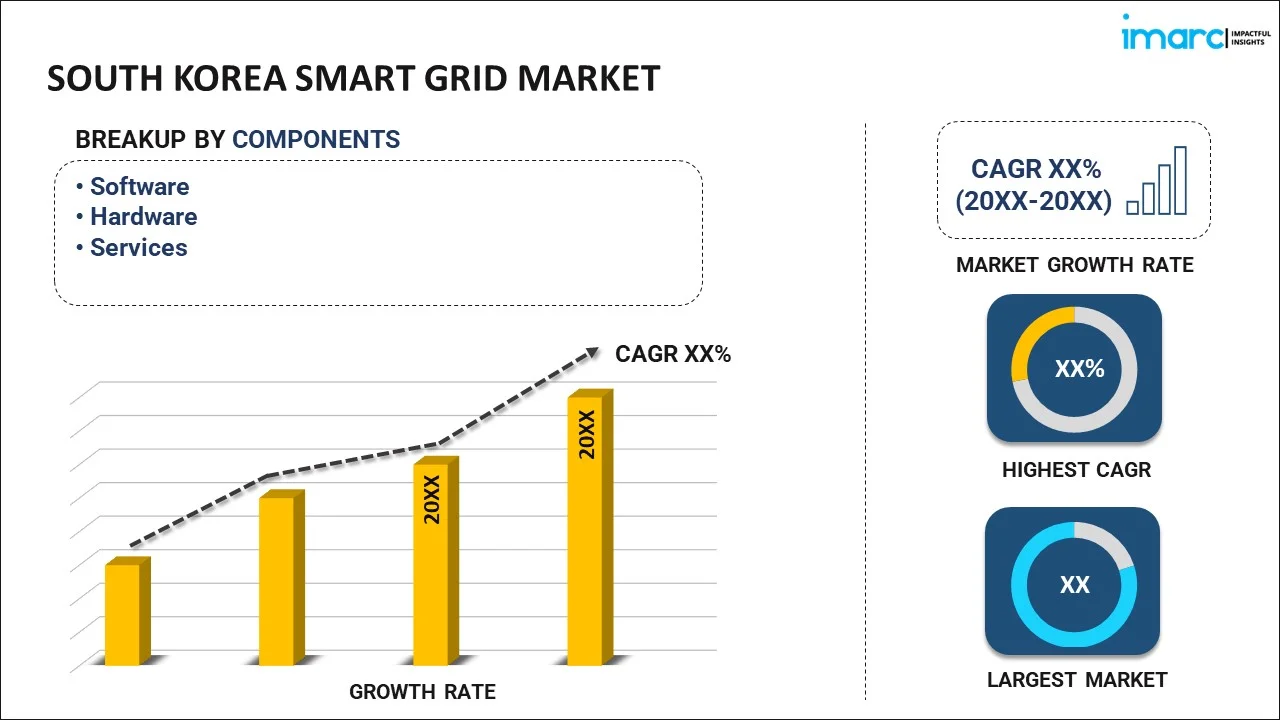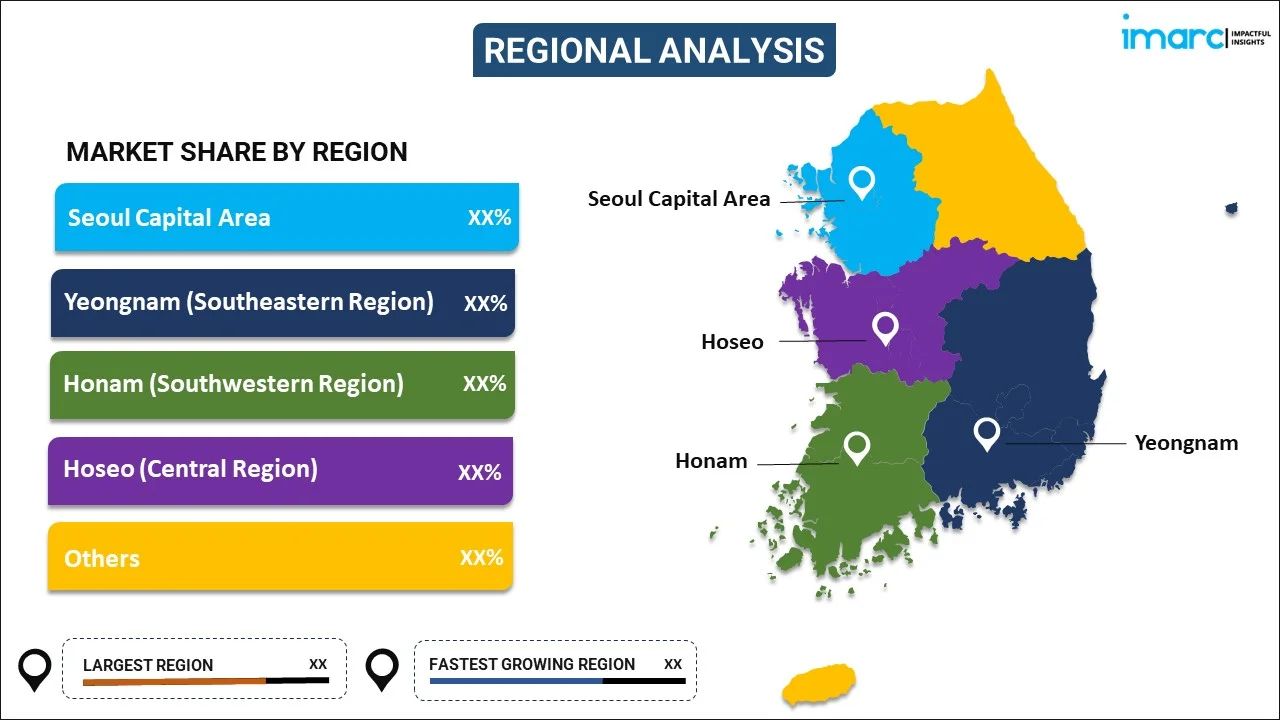
South Korea Smart Grid Market Report by Component (Software, Hardware, Services), End User (Residential, Commercial, Industrial), and Region 2025-2033
Market Overview:
The South Korea smart grid market size is projected to exhibit a growth rate (CAGR) of 4.28% during 2025-2033. The increasing adoption of renewable energy sources, the rising investments in grid modernization initiatives, the growing global demand for energy efficiency and conservation, the escalating grid reliability and resilience, and the evolution of the Internet of Things (IoT) and communication technologies are some of the factors propelling the market.
|
Report Attribute
|
Key Statistics
|
|---|---|
|
Base Year
|
2024 |
|
Forecast Years
|
2025-2033
|
|
Historical Years
|
2019-2024
|
| Market Growth Rate (2025-2033) | 4.28% |
A smart grid is a sophisticated and technologically advanced electricity distribution network that leverages digital communication and information technology to enhance the efficiency, reliability, and sustainability of the traditional power grid. Unlike conventional grids, smart grids incorporate a two-way flow of information and electricity between power providers and consumers. These grids utilize advanced sensors, meters, and automation systems to gather real-time data on energy usage, grid performance, and equipment health. The integration of smart meters allows for precise monitoring of energy consumption patterns, enabling utilities to implement demand response programs and consumers to make informed decisions about their electricity usage. Moreover, smart grids facilitate the seamless integration of renewable energy sources, such as solar and wind power, by intelligently managing the variability and unpredictability associated with these resources. The implementation of smart grid technologies also enhances grid resilience, as automated systems can quickly detect and respond to faults or disruptions, minimizing downtime and improving overall reliability. Additionally, smart grids support the evolution of electric vehicles, energy storage systems, and other innovative technologies, contributing to a more sustainable and interconnected energy ecosystem. The overarching goal of a smart grid is to create a dynamic, self-healing, and adaptable electricity infrastructure that meets the evolving needs of modern society while promoting energy efficiency and environmental stewardship.
South Korea Smart Grid Market Trends:
The market in South Korea is majorly driven by the increasing demand for energy efficiency and sustainability. As governments, utilities, and consumers alike prioritize environmentally conscious practices, the deployment of smart grids becomes integral to optimizing energy usage, reducing wastage, and facilitating the integration of renewable energy sources, thereby aligning with the broader goals of a greener and more sustainable future. Another key factor propelling market growth is the rising complexity of energy systems. As the energy landscape evolves to include distributed energy resources, electric vehicles, and diverse generation sources, the need for an intelligent, adaptable grid becomes imperative. Smart grids address this complexity by leveraging advanced technologies such as sensors, communication networks, and automation to ensure efficient energy management and distribution. Furthermore, grid modernization initiatives undertaken by governments and utility companies globally play a pivotal role in driving the market. Recognizing the limitations of aging infrastructure, stakeholders are investing in upgrading and digitizing power grids. Smart grids offer enhanced monitoring, control, and communication capabilities, providing utilities with real-time insights into grid performance and enabling proactive maintenance, thereby increasing overall reliability. Besides, the integration of advanced communication technologies is another significant driver. The Internet of Things (IoT) and sophisticated communication networks enable seamless connectivity and data exchange among various components of the grid. This interconnectedness allows for better coordination, quicker response times, and improved decision-making, contributing to the overall market expansion. Government policies and regulatory frameworks also play a crucial role in market growth. Several countries are implementing favorable policies to incentivize the adoption of smart grid technologies, offering financial incentives, subsidies, and regulatory support. These measures encourage utilities to invest in smart grid infrastructure, contributing to the market's expansion. Additionally, the increasing frequency and severity of weather-related events and the growing threat of cyber-attacks on critical infrastructure underscore the importance of grid resilience. Smart grids, with their ability to quickly detect, isolate, and respond to disruptions, enhance the overall resilience of the electricity infrastructure, contributing to increased market demand.
South Korea Smart Grid Market Segmentation:
IMARC Group provides an analysis of the key trends in each segment of the market, along with forecasts at the country level for 2025-2033. Our report has categorized the market based on component and end user.
Component Insights:

- Software
- Advanced Metering Infrastructure
- Smart Grid Distribution Management
- Smart Grid Network Management
- Substation Automation
- Others
- Hardware
- Sensor
- Programmable Logic Controller
- AMI Metre
- Networking Hardware
- Others
- Services
- Consulting
- Support and Maintenance
- Deployment and Integration
The report has provided a detailed breakup and analysis of the market based on the component. This includes software (advanced metering infrastructure, smart grid distribution management, smart grid network management, substation automation, and others), hardware (sensor, programmable logic controller, AMI metre, networking hardware, and others), and services (consulting, support and maintenance, and deployment and integration).
End User Insights:
- Residential
- Commercial
- Industrial
A detailed breakup and analysis of the market based on the end user have also been provided in the report. This includes residential, commercial, and industrial.
Regional Insights:

- Seoul Capital Area
- Yeongnam (Southeastern Region)
- Honam (Southwestern Region)
- Hoseo (Central Region)
- Others
The report has also provided a comprehensive analysis of all the major regional markets, which include Seoul Capital Area, Yeongnam (Southeastern Region), Honam (Southwestern Region), Hoseo (Central Region), and Others.
Competitive Landscape:
The market research report has also provided a comprehensive analysis of the competitive landscape in the market. Competitive analysis such as market structure, key player positioning, top winning strategies, competitive dashboard, and company evaluation quadrant has been covered in the report. Also, detailed profiles of all major companies have been provided.
South Korea Smart Grid Market Report Coverage:
| Report Features | Details |
|---|---|
| Base Year of the Analysis | 2024 |
| Historical Period | 2019-2024 |
| Forecast Period | 2025-2033 |
| Units | Million USD |
| Scope of the Report | Exploration of Historical and Forecast Trends, Industry Catalysts and Challenges, Segment-Wise Historical and Predictive Market Assessment:
|
| Components Covered |
|
| End Users Covered | Residential, Commercial, Industrial |
| Regions Covered | Seoul Capital Area, Yeongnam (Southeastern Region), Honam (Southwestern Region), Hoseo (Central Region), Others |
| Customization Scope | 10% Free Customization |
| Post-Sale Analyst Support | 10-12 Weeks |
| Delivery Format | PDF and Excel through Email (We can also provide the editable version of the report in PPT/Word format on special request) |
Key Questions Answered in This Report:
- How has the South Korea smart grid market performed so far and how will it perform in the coming years?
- What has been the impact of COVID-19 on the South Korea smart grid market?
- What is the breakup of the South Korea smart grid market on the basis of component?
- What is the breakup of the South Korea smart grid market on the basis of end user?
- What are the various stages in the value chain of the South Korea smart grid market?
- What are the key driving factors and challenges in the South Korea smart grid?
- What is the structure of the South Korea smart grid market and who are the key players?
- What is the degree of competition in the South Korea smart grid market?
Key Benefits for Stakeholders:
- IMARC’s industry report offers a comprehensive quantitative analysis of various market segments, historical and current market trends, market forecasts, and dynamics of the South Korea smart grid market from 2019-2033.
- The research report provides the latest information on the market drivers, challenges, and opportunities in the South Korea smart grid market.
- Porter's five forces analysis assist stakeholders in assessing the impact of new entrants, competitive rivalry, supplier power, buyer power, and the threat of substitution. It helps stakeholders to analyze the level of competition within the South Korea smart grid industry and its attractiveness.
- Competitive landscape allows stakeholders to understand their competitive environment and provides an insight into the current positions of key players in the market.
Need more help?
- Speak to our experienced analysts for insights on the current market scenarios.
- Include additional segments and countries to customize the report as per your requirement.
- Gain an unparalleled competitive advantage in your domain by understanding how to utilize the report and positively impacting your operations and revenue.
- For further assistance, please connect with our analysts.
 Inquire Before Buying
Inquire Before Buying
 Speak to an Analyst
Speak to an Analyst
 Request Brochure
Request Brochure
 Request Customization
Request Customization




.webp)




.webp)












